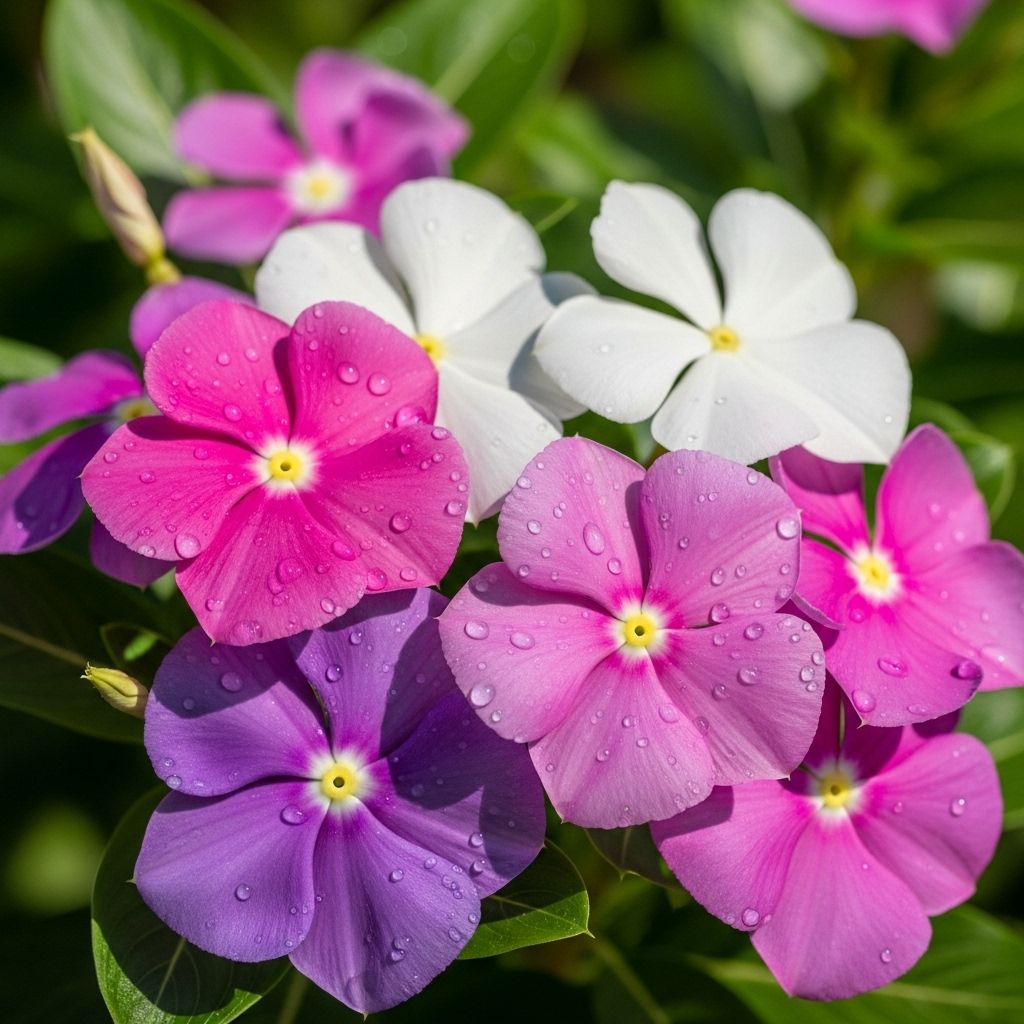How To Grow Vinca Flowers: Complete Guide To Vibrant Blooms
Discover stunning blooms all season long with easy tips for vibrant garden success!

Image: HearthJunction Design Team
A Complete Guide to Growing Annual Vinca Flowers
Annual vinca (Catharanthus roseus), commonly known as Madagascar periwinkle, is a sun-loving, heat-tolerant annual flower that has earned its status as a favorite in both southern and northern gardens. Noted for its steady performance in the hottest summers and through dry spells, vinca’s vibrant colors and versatility make it a must-have flowering plant for flower beds, borders, and container gardens. This guide explores everything you need to know about annual vinca—from top varieties to expert planting and care tips, as well as creative design uses and frequently asked questions.
Vinca Flower Basics
Vinca flowers are beloved for their ability to thrive in hot, sunny climates and produce a carpet of vibrant blooms from late spring right through the first autumn frost. Traditionally, vinca blooms appeared in gentle pastel pinks and whites, but modern varieties now showcase a spectrum that spans grape, blackberry, apricot, cherry red, tangerine, and even unique bicolor options.
- Height & Spread: Most annual vinca varieties grow between 8 to 24 inches tall and equally wide, with new trailing types available for containers and hanging baskets.
- Flowering Period: Continuous blooming from May until frost, with minimal maintenance required.
- Heat & Drought Tolerance: Exceptional resilience in high temperatures and dry soil, perfect for heat-challenged regions.
If you love the look of impatiens but need a low-maintenance flower that thrives in direct sun, vinca is your answer. Unlike impatiens, which often struggle in summer heat, vinca remains vibrant and floriferous all season long.
Our Favorite Annual Vinca Varieties
The world of vinca has expanded far beyond the ordinary. Breeders offer an impressive portfolio with improved disease resistance, more intense colors, and varying growth habits. Here’s a look at some standout series:
- Heatwave Series: Exceptionally heat-tolerant, these grow about 10 inches tall with dense branching and are ideal for challenging climates.
- Cora XDR Series: Upright mounding growth habit; plants reach 14–16 inches high and spread up to 20 inches. Known for robust health and resistance to disease.
- Mediterranean Series: Low-growing (about 6 inches) and spreading — perfect for hanging baskets and cascading containers.
- Pacifica Series: Early-flowering with a broad palette, including the sought-after ‘Pacifica Red’ (the first true red vinca).
- Tattoo Series: Unique, airbrushed flower petals with artistic brushstroke patterns. Upright plants, 10–14 inches tall.
- Mega Bloom Series: Boasts the largest vinca flowers available from seed, reaching 8–10 inches in height. Developed for resistance to heat, humidity, and fungal issues.
- Titan Series: Large, early-blooming flowers on sturdy, well-branched plants (14–16 inches tall).
- Stardust Series: Notable for a white starburst in the center of each flower; 14–16 inches tall and wide.
Growing Tips for Annual Vinca
Site Selection
- Light: Vinca thrives in full sun but will tolerate partial shade, especially in hotter regions.
- Soil: Prefers well-drained, compost-enriched soil. Avoid planting in areas with poorly drained or waterlogged earth, as vinca is susceptible to root rot.
Planting
- Timing: Transplant outdoors after all danger of frost has passed and soils have warmed.
- Spacing: Space plants 8–12 inches apart for most varieties (refer to seed packet or label for specific recommendations).
- Sowing Seed: Start vinca seed indoors 10–12 weeks before the last expected frost, or purchase healthy nursery transplants for easier establishment.
Watering and Feeding
- Watering: Water new plantings regularly until well-established, then reduce frequency. Established plants prefer to dry slightly between waterings and are drought-tolerant. Avoid overhead watering to reduce disease risks.
- Fertilizer: Incorporate a balanced slow-release fertilizer at planting time, or feed with a water-soluble formula once a month during active growth for robust blooming.
Mulching and Maintenance
- Mulching: A 1–2 inch layer of organic mulch helps retain moisture and suppress weeds, but keep the mulch away from the plant stems to discourage rot.
- Deadheading: Not required—vinca is self-cleaning! Old blooms drop off naturally, and fresh flowers emerge continuously.
Caring for Vinca: Year-Round Health and Beauty
Pest & Disease Management
- Root Rot: The most significant issue for vinca, usually caused by overly wet or poorly draining soil. Ensure sites are well-drained, and avoid excessive irrigation.
- Fungal Issues: Newer series (like Cora XDR and Mega Bloom) feature enhanced resistance. Space plants to allow for air circulation and avoid overhead watering when possible.
- Other Pests: Vinca is largely pest-resistant, but occasional aphids or spider mites may appear. Treat with insecticidal soap if necessary.
Overwintering & Self-Sowing
- Annual vinca completes its life cycle in one season, but mature plants may drop seeds that germinate the following year in warm climates.
- In colder zones, treat vinca as annual and replant each spring.
Design Ideas and Landscape Uses
Annual vinca is prized for its versatility and ease of use in a wide variety of garden settings. Here are some inspiring ways to incorporate vinca into your landscape:
- Flower Beds & Borders: Compact varieties create tidy edging or can be mass-planted for a lively carpet of color.
- Container Gardening: Trailing and mounding types spill attractively over pots, window boxes, and hanging baskets.
- Vertical Interest: Upright forms add height and structure when paired with low-growing companions like marigolds or dusty miller.
- Standalone Features: Use vivid vinca as focal points among contrasting foliage plants, or plant them with other drought-tolerant favorites for low-maintenance garden beds.
For striking visual appeal, experiment with color pairings: match pink vinca with yellow marigolds, or blend white vinca with blue salvia and purple petunias for bold contrast.
Table: Summary of Popular Annual Vinca Series
| Series Name | Height | Bloom Characteristics | Special Features |
|---|---|---|---|
| Heatwave | 10 inches | Abundant, heat-resistant blooms | Handles heat and cool spells |
| Cora XDR | 14–16 inches | Large, upright flowers | Disease resistant |
| Mediterranean | 6 inches | Trailing, spreading flowers | Great for baskets |
| Pacifica | 12–14 inches | Early, colorful blooms | First true red variety |
| Tattoo | 10–14 inches | Artistic brushstroke petals | Unique colors |
| Mega Bloom | 8–10 inches | Largest flowers | Heat/humidity/fungal resistance |
| Titan | 14–16 inches | Large, early flowers | Strong branching |
| Stardust | 14–16 inches | Starburst pattern | Eye-catching, award-winning |
Annual Vinca Picture Gallery
Annual vinca is available in an impressive array of vivid colors and forms. Modern cultivars deliver consistently stunning displays, whether planted en masse, in containers, or as accent features. Explore garden inspiration photos on social platforms like Pinterest for creative planting ideas.
Frequently Asked Questions (FAQs)
What is the difference between annual vinca and perennial periwinkle?
Annual vinca (Catharanthus roseus) is unrelated to the perennial periwinkle (Vinca minor or Vinca major), despite the common name. Annual vinca is grown for its colorful summer blooms and heat tolerance, while perennial periwinkle is mainly valued for evergreen foliage and spring flowers.
Is annual vinca deer resistant?
Annual vinca is generally considered deer resistant due to its tough, leathery foliage, though no plant is entirely deer-proof.
Can vinca grow in shade?
Vinca will tolerate partial shade but performs best with at least 6 hours of direct sunlight daily. Too much shade may lead to fewer blooms and leggy growth.
Do vinca flowers self-seed?
In warm climates, vinca may drop seeds that germinate in subsequent years, producing new plants without replanting. In cooler areas, vinca behaves strictly as an annual and does not overwinter.
How often should vinca be watered?
Water regularly after planting, but allow established plants to dry slightly between waterings. Vinca is drought-tolerant and prefers not to have consistently wet soil.
Key Takeaways
- Annual vinca is a heat and drought-tolerant annual flower ideal for sunny garden beds, borders, and containers.
- Available in a wide range of colors and growth habits, including upright, dwarf, and trailing forms.
- Choose disease-resistant modern varieties for best results in humid or rainy climates.
- Easy to grow with minimal maintenance—perfect for both new and experienced gardeners.
- Explore creative design uses, from mass plantings to colorful container gardens, to add season-long color to your landscape.
References
Read full bio of Shinta












